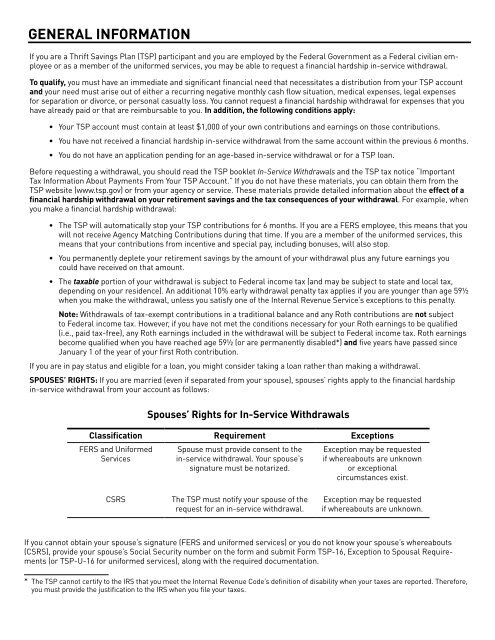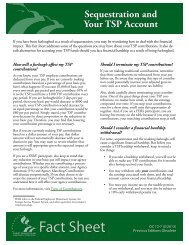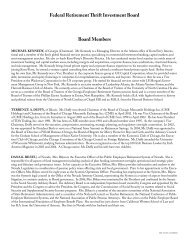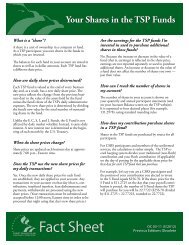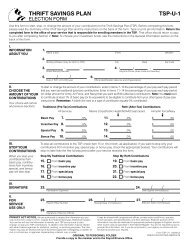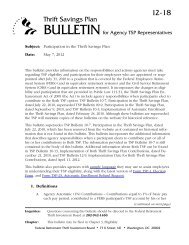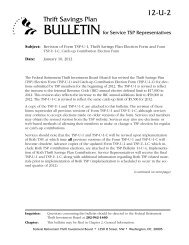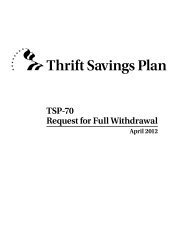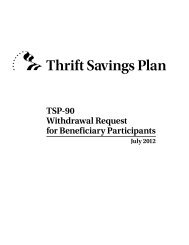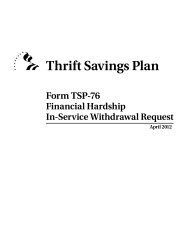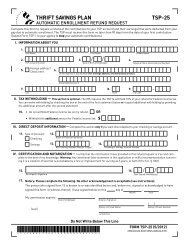PDF, 265 KB - Thrift Savings Plan
PDF, 265 KB - Thrift Savings Plan
PDF, 265 KB - Thrift Savings Plan
Create successful ePaper yourself
Turn your PDF publications into a flip-book with our unique Google optimized e-Paper software.
GENERAL INFORMATION<br />
If you are a <strong>Thrift</strong> <strong>Savings</strong> <strong>Plan</strong> (TSP) participant and you are employed by the Federal Government as a Federal civilian employee<br />
or as a member of the uniformed services, you may be able to request a financial hardship in-service withdrawal.<br />
To qualify, you must have an immediate and significant financial need that necessitates a distribution from your TSP account<br />
and your need must arise out of either a recurring negative monthly cash flow situation, medical expenses, legal expenses<br />
for separation or divorce, or personal casualty loss. You cannot request a financial hardship withdrawal for expenses that you<br />
have already paid or that are reimbursable to you. In addition, the following conditions apply:<br />
• Your TSP account must contain at least $1,000 of your own contributions and earnings on those contributions.<br />
• You have not received a financial hardship in-service withdrawal from the same account within the previous 6 months.<br />
• You do not have an application pending for an age-based in-service withdrawal or for a TSP loan.<br />
Before requesting a withdrawal, you should read the TSP booklet In-Service Withdrawals and the TSP tax notice “Important<br />
Tax Information About Payments From Your TSP Account.” If you do not have these materials, you can obtain them from the<br />
TSP website (www.tsp.gov) or from your agency or service. These materials provide detailed information about the effect of a<br />
financial hardship withdrawal on your retirement savings and the tax consequences of your withdrawal. For example, when<br />
you make a financial hardship withdrawal:<br />
• The TSP will automatically stop your TSP contributions for 6 months. If you are a FERS employee, this means that you<br />
will not receive Agency Matching Contributions during that time. If you are a member of the uniformed services, this<br />
means that your contributions from incentive and special pay, including bonuses, will also stop.<br />
• You permanently deplete your retirement savings by the amount of your withdrawal plus any future earnings you<br />
could have received on that amount.<br />
• The taxable portion of your withdrawal is subject to Federal income tax (and may be subject to state and local tax,<br />
depending on your residence). An additional 10% early withdrawal penalty tax applies if you are younger than age 59½<br />
when you make the withdrawal, unless you satisfy one of the Internal Revenue Service’s exceptions to this penalty.<br />
Note: Withdrawals of tax-exempt contributions in a traditional balance and any Roth contributions are not subject<br />
to Federal income tax. However, if you have not met the conditions necessary for your Roth earnings to be qualified<br />
(i.e., paid tax-free), any Roth earnings included in the withdrawal will be subject to Federal income tax. Roth earnings<br />
become qualified when you have reached age 59½ (or are permanently disabled*) and five years have passed since<br />
January 1 of the year of your first Roth contribution.<br />
If you are in pay status and eligible for a loan, you might consider taking a loan rather than making a withdrawal.<br />
SPOUSES’ RIGHTS: If you are married (even if separated from your spouse), spouses’ rights apply to the financial hardship<br />
in-service withdrawal from your account as follows:<br />
Spouses’ Rights for In-Service Withdrawals<br />
Classification Requirement Exceptions<br />
FERS and Uniformed<br />
Services<br />
CSRS<br />
Spouse must provide consent to the<br />
in-service withdrawal. Your spouse’s<br />
signature must be notarized.<br />
The TSP must notify your spouse of the<br />
request for an in-service withdrawal.<br />
Exception may be requested<br />
if whereabouts are unknown<br />
or exceptional<br />
circumstances exist.<br />
Exception may be requested<br />
if whereabouts are unknown.<br />
If you cannot obtain your spouse’s signature (FERS and uniformed services) or you do not know your spouse’s whereabouts<br />
(CSRS), provide your spouse’s Social Security number on the form and submit Form TSP-16, Exception to Spousal Requirements<br />
(or TSP-U-16 for uniformed services), along with the required documentation.<br />
* The TSP cannot certify to the IRS that you meet the Internal Revenue Code’s definition of disability when your taxes are reported. Therefore,<br />
you must provide the justification to the IRS when you file your taxes.


